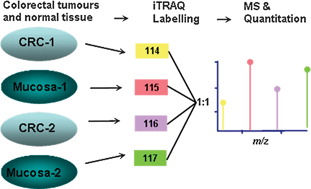Proteomic comparison of colorectal tumours and non-neoplastic mucosa from paired patient samples using iTRAQ mass spectrometry†
Abstract
Quantitative

Maintenance work is planned for Wednesday 1st May 2024 from 9:00am to 11:00am (BST).
During this time, the performance of our website may be affected - searches may run slowly and some pages may be temporarily unavailable. If this happens, please try refreshing your web browser or try waiting two to three minutes before trying again.
We apologise for any inconvenience this might cause and thank you for your patience.
* Corresponding authors
a Cancer Pharmacology Unit, ANZAC Research Institute and Discipline of Medicine, The University of Sydney, Sydney, Australia
b Department of Anatomical Pathology, Concord Repatriation General Hospital, Sydney, Australia
c
Australian Proteome Analysis Facility, Dept. Chemistry & Biomolecular Sciences, Macquarie University, Sydney, Australia
E-mail:
mmolloy@proteome.org.au
Fax: + 61 2 9850 6200
Tel: + 61 2 9850 6218
d Peter Wills Bioinformatics Centre, The Garvan Institute of Medical Research, Sydney, Australia
e Department of Colorectal Surgery, Concord Repatriation General Hospital and Discipline of Surgery, The University of Sydney, Sydney, Australia
f Department of Medicine, Concord Repatriation General Hospital and Discipline of Medicine, The University of Sydney, Sydney, Australia
Quantitative

 Please wait while we load your content...
Something went wrong. Try again?
Please wait while we load your content...
Something went wrong. Try again?
L. Jankova, C. Chan, C. L. S. Fung, X. Song, S. Y. Kwun, M. J. Cowley, W. Kaplan, O. F. Dent, E. L. Bokey, P. H. Chapuis, M. S. Baker, G. R. Robertson, S. J. Clarke and M. P. Molloy, Mol. BioSyst., 2011, 7, 2997 DOI: 10.1039/C1MB05236E
To request permission to reproduce material from this article, please go to the Copyright Clearance Center request page.
If you are an author contributing to an RSC publication, you do not need to request permission provided correct acknowledgement is given.
If you are the author of this article, you do not need to request permission to reproduce figures and diagrams provided correct acknowledgement is given. If you want to reproduce the whole article in a third-party publication (excluding your thesis/dissertation for which permission is not required) please go to the Copyright Clearance Center request page.
Read more about how to correctly acknowledge RSC content.
 Fetching data from CrossRef.
Fetching data from CrossRef.
This may take some time to load.
Loading related content
